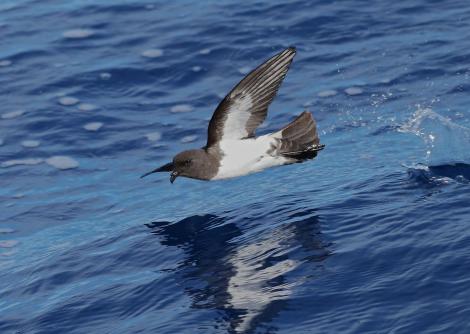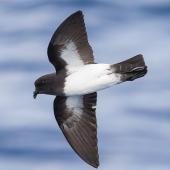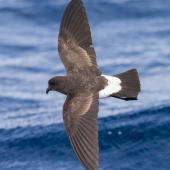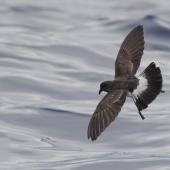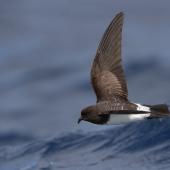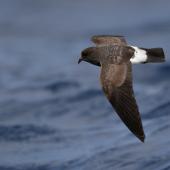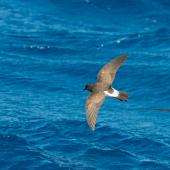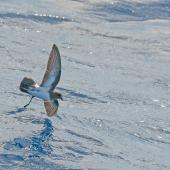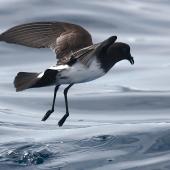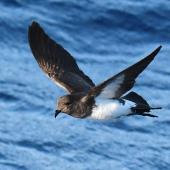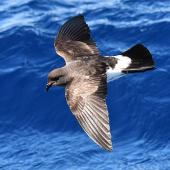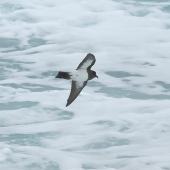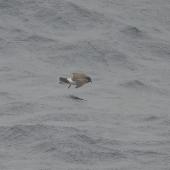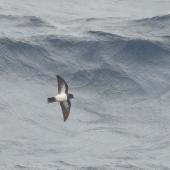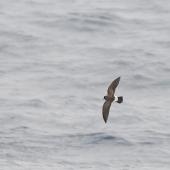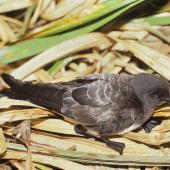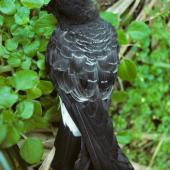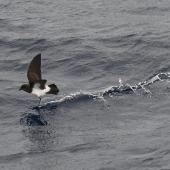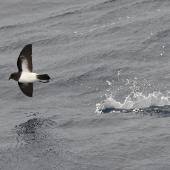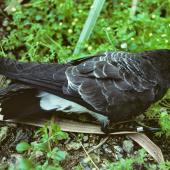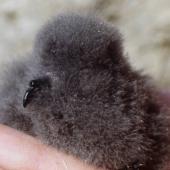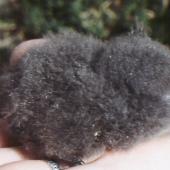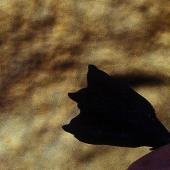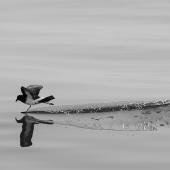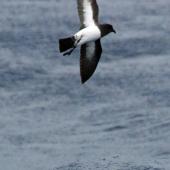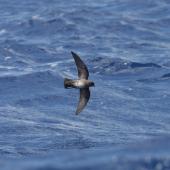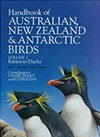White-bellied storm petrel
Fregetta grallaria (Vieillot, 1818)
Order: Procellariiformes
Family: Oceanitidae
New Zealand status: Native
Conservation status: Nationally Endangered
Other names: Vieillot’s storm petrel, broad-tailed storm petrel, whitebellied storm petrel, white bellied storm petrel
Geographical variation: Four subspecies recognised; New Zealand birds are of the nominate subspecies F. g. grallaria.
The white-bellied storm petrel is a small, uncommon, little-studied seabird that nests only on remote islands. The species has a few widely dispersed breeding sites in the South Pacific, South Atlantic and South Indian Oceans and was only discovered nesting in the New Zealand region in 1966. The specific name is derived from the Latin grallae meaning stilts, which is presumed to refer to the birds’ long legs.
Identification
The white-bellied storm petrel is a small black-and-white storm petrel with a black ‘hood’ and a white rump. Dorsally the plumage is mainly blackish but birds in fresh plumage have distinctive white tips to their dorsal feathers. Ventrally the feathers are largely white but the plumage can be variable, so that the rump and underside may have considerable numbers of darker feathers (observed on Curtis Island, Kermadec Islands). At Lord Howe, some birds are almost entirely dark. The beak, legs and feet (including webs and claws) are black and the claws are distinctly flattened. Birds of all ages and sexes have similar plumage.
Voice: white-bellied storm petrels are generally silent but birds at nest sites give soft high-pitched twittering calls, such as pee-pee-pee-pee repeated up to 20 times.
Similar species: white-bellied storm petrels can be confused with other black-and-white storm petrels, but all these have relatively longer legs, with feet that usually project beyond the tail in flight. Wilson’s storm petrels are smaller, always have a dark underside and have yellow webs. Black-bellied storm petrels usually have a black stripe or mark along their central belly. New Zealand storm petrels have irregular black streaking on the underside.
Distribution and habitat
Within the New Zealand region and Tasman Sea, the white-bellied storm petrel breeds only at the Lord Howe and Kermadec Islands. It is a pelagic seabird so spends most of its life at sea and, in New Zealand waters, is usually seen only near the Kermadec Islands. There are six claimed records from further south, but most of the sight records may have been of New Zealand storm petrels, which were not considered as a possibility before their rediscovery in 2003. Records reported as white-bellied storm petrels include: 2 off Farewell Spit (November 1969), off the Poor Knights Islands (December 1969), Waikawa Beach (July 1975), Ninety Mile Beach (April 1978), Piha Beach (May 1985), Hauraki Gulf (January 1991); only the 1978 record is undoubtedly this species. The local subspecies of white-bellied storm petrel has a mainly tropical distribution and ranges or migrates as far as the Coral Sea and eastern tropical Pacific Ocean, but some remain close to the breeding colonies throughout most of the year.
Population
The white-bellied storm petrel is rare in New Zealand. Up to 700 have been estimated to nest on Macauley and Curtis Islands in the Kermadec group, with the stronghold being Curtis Island where 23 adults were caught in 1989. More than 1,000 pairs may nest at the Lord Howe group but the species is extinct on the main island. Rare at-sea sightings off the Kermadec Islands are normally of single birds.
Breeding
Poorly known. On Curtis Island, a single, long-abandoned fragmentary egg, thought to be of white-bellied storm petrel, was found in 1989, and a small downy chick, estimated to be three weeks old, was found on 21 May 1982, which suggests that laying occurs from April. A dead nearly-fledged chick was found on Macauley Island on 3 August 1966, which indicates that it came from an egg laid in April-May. At other nesting sites, the species breeds in loose colonies and the egg and chick period is January to May.
Behaviour and ecology
The rarity of this species partly accounts for its relative inconspicuousness both ashore and at sea. Ashore it is strictly nocturnal. At sea, white-bellied storm petrels fly low above the water, usually gliding and pushing off the water’s surface with their legs.
Food
White-bellied storm petrels consume small squids and crustaceans but little detail is known. They feed by skipping across the water surface and dipping to catch prey.
Websites
http://www.environment.gov.au/cgi-bin/sprat/public/publicspecies.pl?taxon_id=64438
References
Marchant, S.; Higgins, P.J. (eds) 1990. Handbook of Australian, New Zealand and Antarctic birds. Vol.1, ratites to ducks. Oxford University Press, Melbourne.
Spear, L.B.; Ainley, D.G. 2007. Storm-petrels of the eastern Pacific Ocean: species assembly and diversity along marine habitat gradients. American Ornithologists’ Union Ornithological Monographs 62: I-xii + 1-77.
Stephenson, B.M.; Flood, R.; Thomas, B.; Saville, S. 2008. Rediscovery of the New Zealand storm petrel (Pealeornis maoriana Mathews 1932): two sightings that revised our knowledge of storm petrels. Notornis 55: 77-83.
Tennyson, A.J.D. 2010. Procellariiformes. Pp. 64-135. In: Checklist Committee (OSNZ) 2010. Checklist of the birds of New Zealand, Norfolk and Macquarie Islands, and the Ross Dependency, Antarctica (4th ed.). Ornithological Society of New Zealand & Te Papa Press, Wellington.
Veitch, C.R.; Miskelly, C.M.; Harper, G.A.; Taylor, G.A.; Tennyson, A.J.D. 2004. Birds of the Kermadec Islands, south-west Pacific. Notornis 51: 61-90.
Recommended citation
Tennyson, A.J.D. 2013. White-bellied storm petrel. In Miskelly, C.M. (ed.) New Zealand Birds Online. www.nzbirdsonline.org.nz
White-bellied storm petrel
- Breeding season
-
- Jul
- Aug
- Sep
- Oct
- Nov
- Dec
- Jan
- Feb
- Mar
- Apr
- May
- Jun
- Egg laying dates
-
- Jul
- Aug
- Sep
- Oct
- Nov
- Dec
- Jan
- Feb
- Mar
- Apr
- May
- Jun
White-bellied storm petrel
- Breeding season
-
- Jul
- Aug
- Sep
- Oct
- Nov
- Dec
- Jan
- Feb
- Mar
- Apr
- May
- Jun
- Nest type
- burrow, rock crevice
- Nest description
- In rock crevices, caves or burrows. Nests sometimes lined with vegetation.
- Nest height (mean)
- 0.00 m
- Maximum number of successful broods
- 1
- Clutch size (mean)
- 1
- Mean egg dimensions (length)
- 36.30 mm
- Mean egg dimensions (width)
- 26.40 mm
- Egg colour
- White with faint red-brown or pink spots
- Egg laying dates
-
- Jul
- Aug
- Sep
- Oct
- Nov
- Dec
- Jan
- Feb
- Mar
- Apr
- May
- Jun
- Interval between eggs in a clutch
- Not applicable
- Incubation length (mean)
- Unknown
- Nestling type
- altricial
- Nestling period (mean)
- Unknown
- Age at fledging (mean)
- Unknown
- Age at independence (mean)
- Unknown
- Age at first breeding (typical)
- Unknown
- Maximum longevity
- Unknown
- Maximum dispersal
- Several thousand kilometres




